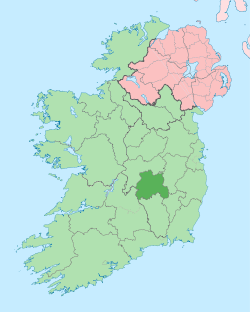Rathdowney
| Rathdowney Ráth Domhnaigh | |
|---|---|
| Village | |
 Rathdowney Location in Ireland | |
| Coordinates: 52°51′19″N 7°35′05″W / 52.8554°N 7.5848°WCoordinates: 52°51′19″N 7°35′05″W / 52.8554°N 7.5848°W | |
| Country | Ireland |
| Province | Leinster |
| County | County Laois |
| Elevation | 100 m (300 ft) |
| Population (2011)[1] | |
| • Urban | 1,208 |
| Irish Grid Reference | S279783 |
Rathdowney or Rathdowny (Irish: Ráth Domhnaigh) is a town in southwest County Laois, Ireland. It lies some 32 km southwest of Portlaoise in the Irish Midlands, at the point where the R433 regional road from Abbeyleix to Templemore is crossed by the R435 from Borris-in-Ossory to Johnstown. The R433 provides access for Rathdowney to the Dublin-Cork M8 motorway, while the R435 links the town to the Dublin-Limerick M7. According to the 2011 census the population stands at 1,208.
History
Rathdowney is named after a nearby ringfort, or ráth, which was levelled in 1830. This ráth is mentioned three times in the Annals of the Four Masters:
- 874 Flaithri, son of Maelduin, Lord of Rath-Tamhnaighe (Rathdowney) died
- 909 Maelpadraig, son of Flaithri, Lord of Rath-Tamhnaighe, died
- 1069 Gillamoula, grandson of Bruaideadh, Lord of Rath-Tamhnaighe
The settlement of Rathdowney has existed since at least the 9th century. Historically it forms part of the Kingdom of Osraige, and today it remains part of the Roman Catholic Diocese of Ossory, as such Rathdowney is not historically part of Laois. The present-day county of Laois is a modern administrative construct. A half mile southeast of Rathdowney, there stood until 1836, the ruins of a castle called Rathpiper, which most probably took its name from "Pipard", a descendant of Adam de Hereford.[2] This locality of "Pyperath" within Rathdowny parish appears to have been a royal site associated with the medieval Mac Giolla Phádraig dynasty, as documents relating to meeting there in 1558 show.[3]
The Croppy's Grave located in the town's central square is the still visible cobbled grave of a croppy revolutionary hanged and buried there in 1798. The site also contains a recent memorial.
The town was raided at least once by anti-treaty forces during the Irish Civil War of 1922 to 1923.
Queen Victoria passed through Rathdowney during her first visit to Ireland in 1849 and in a letter to her maternal sibling Princess Feodora of Leiningen about the visit to Ireland she described passing through a town assumed to be Rathdowney by historians as "a quaint village, surrounded by hills" and went on to describe it as "an idyllic small town".
.jpg)
.jpg)
Churches
Saint Andrew's Church of Ireland church, which dominates the square and the town to a lesser degree; stands on the traditional site of an older Roman Catholic church, which was located there from medieval times until the Reformation. A new Catholic church was constructed on Main Street in the 1830s this church served the catholic population of the area for the next 120 years before it too was tumbled; to be replaced by a shrine and carpark. A new larger, modern Catholic church, the Church of the Holy Trinity, was built on the west side of the town and opened in the late 1950s.
Some "mass pits" or outdoor areas used for Catholic masses during penal times are located in the vicinity of the town and are well signposted for those interested.
Economy
The Meadow Meats processing plant is part of the Dawn Meats Group and was the largest employer in the town. This factory stands on the old Perry's Brewery site, it was purchased by Lyons Meats in 1968 and converted by them to a meat processing facility, which went into production in 1971.The largest employer currently is Dunnes Store Ltd. Rathdowney is also something of a centre for several out lying villages and is the focal point of a large agricultural hinterland.
People
- John Moyney, an Irish recipient of the Victoria Cross, was born in Rathdowney.
- Another Victoria Cross recipient, James Pearson, was also from Rathdowney.
- John Maher's novel The Luck Penny (Brandon 2007) is set in Rathdowney, in 1849. It is loosely based on the life of the Church of Ireland minister and Assyriologist Dr Edward Hincks.
- James Ryan, an Irish novelist (South of the Border)
- Tony Byrne an Irish former professional football player was born in Rathdowney in 1946.
See also
References
- ↑ http://cso.ie/en/media/csoie/census/documents/census2011vol1andprofile1/Table%205.pdf
- ↑ https://books.google.com/books?id=cPMQAwAAQBAJ&pg=PA6&lpg=PA6&dq=rathpiper+castle+ireland&source=bl&ots=eK8BJ0sHzP&sig=8hemM1PwFr4XaJN53wZTA3oym08&hl=en&sa=X&ved=0ahUKEwjDsK6m4qrNAhXFpR4KHaWgBy0Q6AEIOTAF#v=onepage&q=rathpiper%20castle%20ireland&f=false
- ↑ https://books.google.com/books?id=cscQwIzZr70C&pg=PA24&lpg=PA24&dq=rathpiper+castle+ireland&source=bl&ots=8EbRLlRU4X&sig=np6SICNFg0062dBT5z57oFQ4bLU&hl=en&sa=X&ved=0ahUKEwigqP25na3NAhXDyyYKHd9ZA2AQ6AEIHDAA#v=onepage&q=rathpiper%20castle%20ireland&f=false
External links
| Wikimedia Commons has media related to Rathdowney. |
